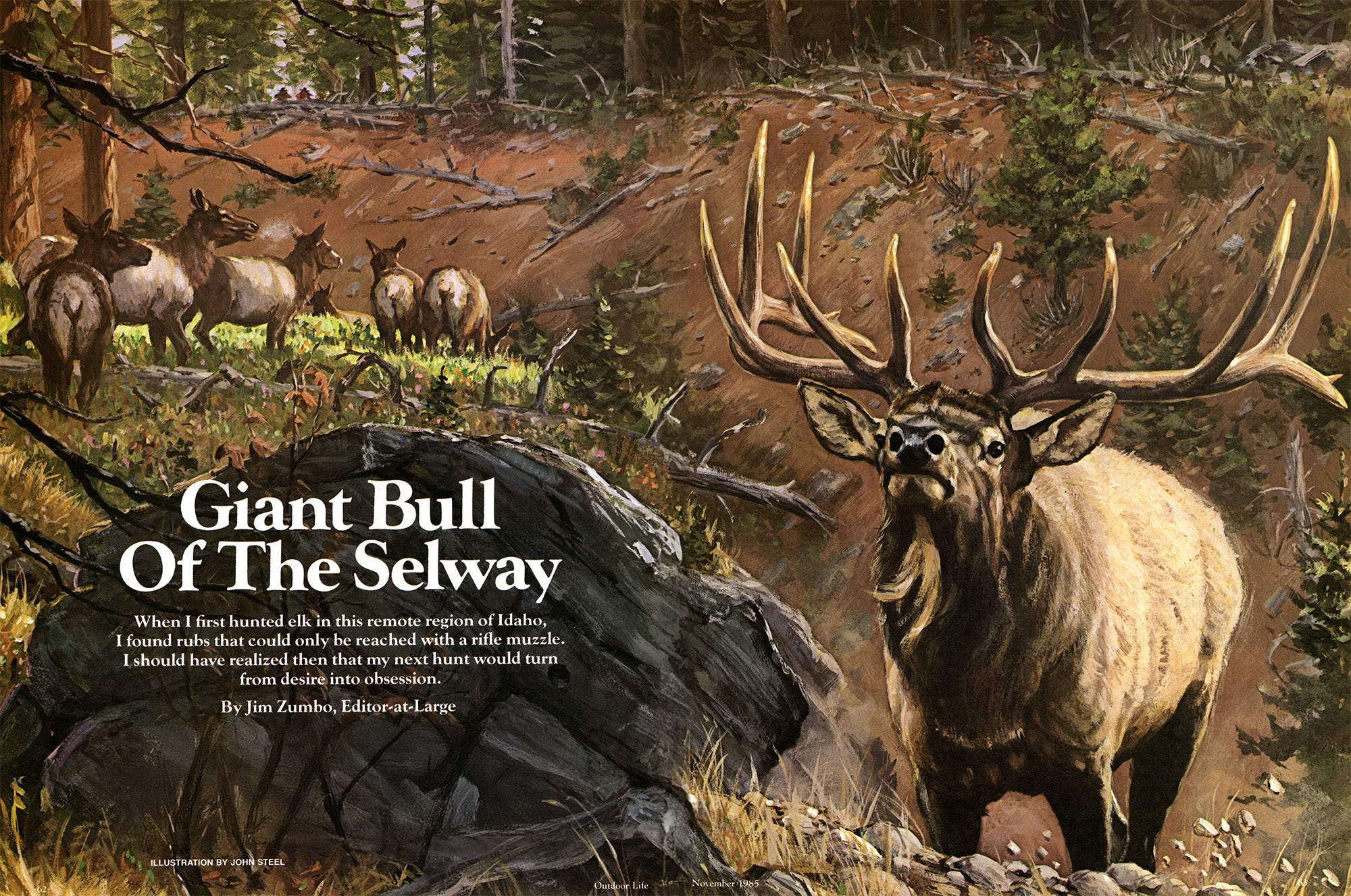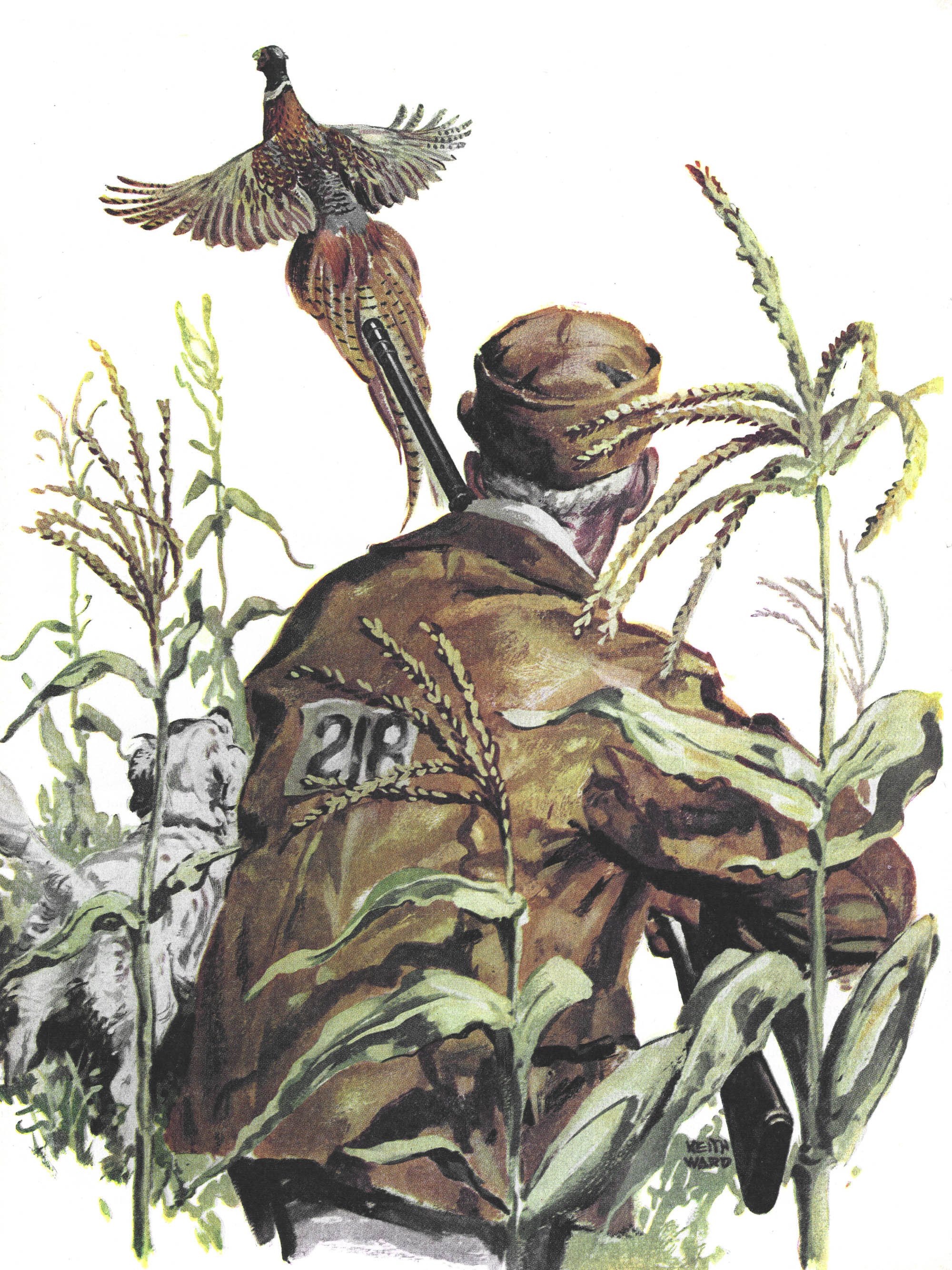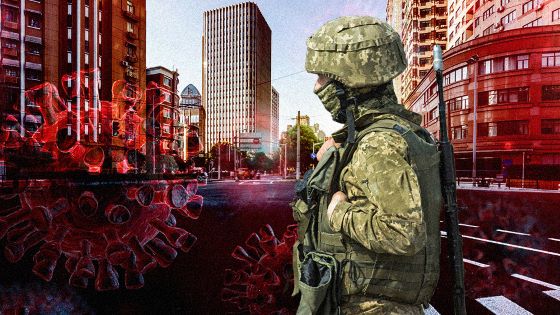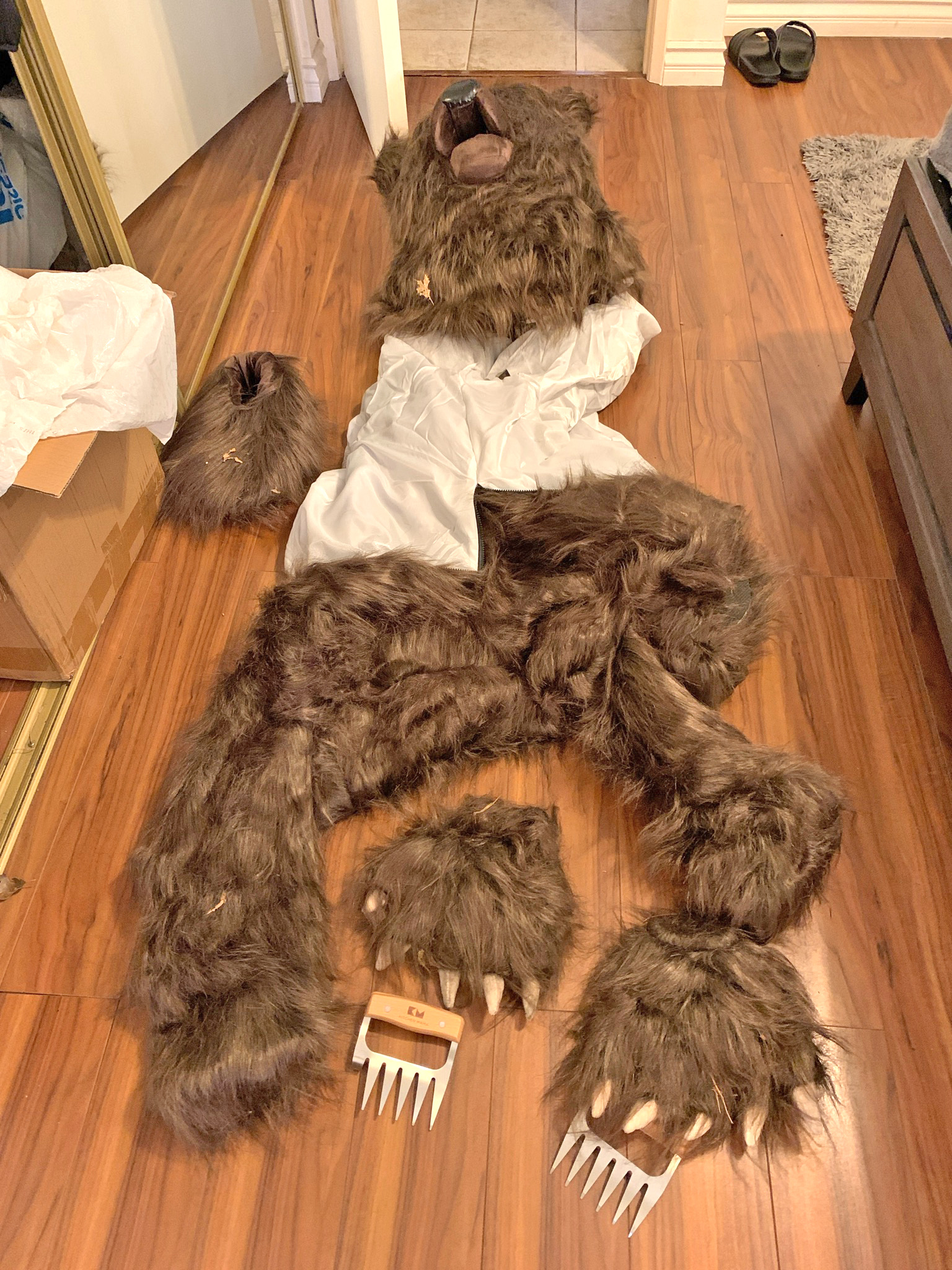Zumbo in Idaho: Stalking a Giant Bull in the Selway Wilderness

The night couldn’t get much darker. I held my hand a few inches in front of my face, but couldn’t see it. Looking up to the sky, I saw nothing — no stars, no blurred images of the trees that were around me — except complete, overwhelming blackness.
I jammed my old Stetson hard over my head to protect my eyes from tree branches, burrowed my chin in to my chest, rested my hands on the saddle horn, and closed my eyes. There was nothing else to do. My horse was in total command.
As I rode, I marveled at the ability of the beast beneath me to see in the total darkness. Skeeter stepped over logs. waded across creeks, and pivoted about here and there to maneuver through timber. In places. he carefully worked his way along narrow trails etched impossibly into steep mountain slopes.
“You still there?” a voice asked from somewhere ahead of me.
“Only in body,” I answered. “I don’t know about my soul.”
Ken Smith laughed heartily, just as an invisible branch slapped me across the face and knocked my hat to the ground. I cussed, dismounted. turned on my small flashlight, and looked for the hat. My horse was standing on it.
This was the fourth day of my elk hunt with Ken, an Idaho outfitter. We were deep in the Selway Wilderness, about 30 miles from the nearest trailhead, and another 30 miles to civilization. I was hoping to tag a big bull and was prepared for anything.
I was enthusiastic about Idaho’s Selway region. The area had been good to me in the past, and l hoped for a repeat performance. In 1983, I took a fine six-point Selway bull with Bruce Scott, an outfitter from Florence, Montana. l killed the bull just 25 air-miles from where I was hunting with Ken.
Fresh elk sign was everywhere. It was impossible to ride very far and not see elk tracks made the night before, even within a few hundred yards of camp.
During the hunt with Bruce, I saw astounding rubs on trees. I stood next to several of those rubbed trees and reached up with my rifle, just barely able to touch the tops of the rubs with the muzzle. There was no question about giant bulls existing in the Selway, and I promised myself I’d come back.
When I first contacted Ken Smith (4239 Old Ahsahka Grade, Ahsahka, ID 83520. 208-476-7148), he was optimistic about a 1984 Selway hunt but, like all reputable outfitters, he couldn’t make any promises. The hunt he outlined was unique. We’d glass extensively from high ridges and if we spotted a good bull, we’d stalk in close for a shot. Glassing was the only method we’d use, and Ken told me to prepare myself for extremely long periods of sitting without moving.
“We’re never in a hurry to leave camp,” Ken explained before the hunt. “We’ll get up about 6:30, eat breakfast, and ride out about 9 in the morning. Nothing much happens until 2 or 3 in the afternoon. because elk don’t start moving until then.”
Ken would get no argument from me about the daily itinerary. On most elk hunts. I was used to awakening at 3 or 4 a. m. and climbing into a frosty saddle well before sunrise. ·
“This won’t be an easy hunt,” Ken told me. as if he was reading my mind. “If we spot a big bull, he’s apt to be a mile or more away, and we won’t have much daylight to get to him. We’ll be riding hard and running hard, and a lot of the running will be uphill. You’ll know you’ve been on an elk hunt when you get back to camp.”
The hunt was planned for mid-November in order to coincide with the elk migration from high country to winter range. If the weather cooperated. Ken figured we’d be looking over plenty of elk in their winter areas.
According to Ken, the region was so remote and undisturbed that elk didn’t remain bedded in the timber as long as usual. But he said the last hour of daylight was the very best.
I had a bird’s-eye view of the Selway on the way to Ken’s camp, prior to the hunt. A flight in a Cessna airplane got me to his base camp in the wilderness, and from there we rode 12 miles on horeseback to his higher camp. Since the dirt landing strip had been in place long before the Selway was declared an official wilderness area, Forest Service officials allowed it to remain. It is one of the few wilderness area airstrips and is used to accommodate recreationists such as hunters and fishermen, as well as forest officers.
It was interesting to note the transition from snow to bare ground from aloft. The camp we’d be staying in had a foot of snow, but Ken had a spike camp, much higher, that was covered with six feet of snow. By the time I arrived, Ken had dismantled the high camp and wouldn’t hunt from it again until the following season. Except for some straggler moose, most big game had moved into lower country.
Each day, we rode from camp down into canyons that were void of snow. An abundance of grass attracted elk, and the remoteness of the region allowed them to graze undisturbed. Unlike some wilderness areas l was familiar with, this region was not blanketed with a carpet of thick evergreen trees from one horizon to the other. The timber was broken by expansive areas of alders and other brushy plants, and open meadows were common.
Fresh elk sign was everywhere. It was impossible to ride very far and not see elk tracks made the night before, even within a few hundred yards of camp. I easily understood why the Selway harbored giant bulls.
The hunt had been uneventful for the first three days. I saw elk, but nothing interested me. Small bulls that would have been welcome on other hunts received just casual interest.
We were about to eat lunch at noon the fourth day when Ken spotted elk just beneath the ridge we were on. I was tying up the horse when he routinely looked over the cop and saw the animals. He motioned for me 10 hurry over with my rifle. so I jerked the .30/06 out of the scabbard and rushed over to where he was kneeling.
Three dozen elk were within 80 yards of us. Some were bedded, but others were standing. nibbling lightly on the yellow grass. I eased down to a prone position, rested my rifle on my jacket, and looked the elk over with binoculars.
We glassed intently for 10 minutes, but couldn’t see a bull. A big cow got to her feet and started grazing. walking slowly as she fed. Other elk followed lazily. and soon the entire herd was moving slowly.
Ken spotted the bull first, and tapped me on the shoulder. l took a good look at the bull, centered the crosshairs on his chest. and snugged the Winchester tight to my shoulder. The bull wasn’t the giant that I had hoped for, but he was respectable. I wasn’t sure what to do.
“What are the chances of seeing a bigger bull?” I asked.
“Fifty-fifty,” Ken replied.
Although I was trophy hunting. one factor encouraged me to consider this bull. When Ken isn’t elk hunting, he guides steelhead fishermen on the Clearwater River near Orofino, and we planned on combining a fishing trip with the elk hunt.
Read Next: The Best Elk Rifles of 2024
If I killed an elk, we’d leave camp immediately and fish for huge 20-pound-plus steelhead below Dworshak Dam. I had been wanting to make the trip with Ken for several years, and this was my opportunity. l couldn’t fish after the hunt. because Thanksgiving was fast approaching. If I wanted to fish with Ken, I had to kill this bull or try for a bigger one that afternoon.
Visions of enormous steelhead flashed in my mind as l weighed the options. l snicked off the safety, drew a deep breath. and put my finger on the trigger.
“Think we can find that big bull your hunter missed last week?’” I whispered to Ken. l was grabbing for excuses, and I hoped Ken would help me make a decision.
““Maybe,” was his simple answer. “We still have three days to hunt after today.”
“Good enough for me,” I said. I flipped the safety back and pushed the rifle away from my face.
“Whew,” Ken breathed. “I was waiting for fire to roar out of your rifle. What changed your mind?”
“Let’s find the giant bull,” l said. “We can fish another time.”
Ken grinned. “I was hoping you’d figure it that way,” he said. “but I didn’t want to sway your decision. If we hunt hard, we might just find that big bull.”
The bull we referred to was spotted by Ken on the hunt prior to mine. His hunter had missed the bull several times, and it hadn’t been seen again. Ken had gotten a quick look at the elk as it ran through brush, and thought it had seven points on at least one side.
We eased away from the elk and allowed them to graze undisturbed. Ken retrieved our lunches from saddlebags and we leaned against trees. munching on cold fried chicken and delicious homemade cookies.
We were chatting in between bites, when Ken suddenly gestured across the canyon. “Elk!” he said. “A half dozen of them — coming out of the timber to feed. And they’re in the same area where my hunter missed the big bull last week.”
Suddenly another cow barked from above us and to our left, and yet another barked from above us and to our right. We were surrounded by elk.
We glassed them. but all were cows and calves. As the shadows lengthened and the sun lowered, more elk appeared. I saw four different herds, all a half-mile away or more, but none had good bulls.
A lone elk far up a mountain slope caught my attention. It was in a sliver of a meadow surrounded by timber, and it had a light yellow body. I knew what that might mean. Old bulls often have very light-colored pelts, and some are almost white.
The elk’s head was in the shadows as it fed, and I couldn’t see antlers. Besides the poor light, another difficulty was that the animal was more than a mile away. I nudged Ken and pointed the elk out to him.
“That’s a big bull!” he said. “A big, big bull. l just caught a glimpse of an antler as he turned his head.”
“Now what, boss?” I asked. “You suppose if I aim 18 feet over his back l can hit him from here?”
“Try 19 feet,” Ken retorted. “We won’t be able to get to him this afternoon. Not enough light left, and there are too many small elk herds scattered below him. We might spook them and run the bull off. We’ll have to try for him tomorrow.”
We kept watching, and soon the bull moved into the waning light, giving us a good look. His antlers were enormous, and Ken thought it was the bull we were looking for. No matter. If I could get close to that elk, I wouldn’t hesitate squeezing the trigger.
Sleep didn’t come easy that night. I kept thinking of the massive antlers and the image of the bull, as it stood silhouetted in the waning light in the distant meadow.
Ken and I rode out of camp at 8 a.m. the next day. It was a nine-mile ride to the elk. and we wanted to arrive there with enough time left to plan a strategy. Ken figured the bull would be in the same general area. and our biggest problem would be to not spook the elk around him.
After riding for three hours, Ken spotted elk from atop his horse, a long way from where we intended to begin glassing. We dismounted, looked at them through binoculars, and counted more than 40 elk. They were much too far away for us to see antlers, and I was amazed that Ken saw the animals at all. Most were bedded in light brush, but a few were feeding. The herd was on a large open face, just a quarter of a mile from where we saw the bull the day before.
“Our bull might be in with that bunch,” Ken said. “Let’s ride as close as we can and give them a good look.”
We rode for more than half a mile and tied our horses in the timber. After donning day packs, we slipped along a spur ridge that fell away into a steep canyon. The elk were across the canyon, at least a mile or so away.
All I saw was antlers, and l had to concentrate hard to focus my attention on the bull’s vital area. The bull was scrambling up a steep slope about 300 yards away when I fired.
Ken and I had walked about a half mile when he gestured to sit. We made ourselves comfortable, propped our binoculars on our knees, and glassed the elk. Immediately, we spotted three bulls, but none wore the antlers we were looking for. We sat another half-hour, but still couldn’t locate the big bull.
“I think we’d better cross the canyon now and take our chances,” Ken said. “We don’t have much choice. Let’s just hope we don’t spook some unseen elk and blow the whole thing.”
We were barely on our feet when a cow barked just below us. She had our number. Cows bark when they’re alarmed.
We froze and a cow walked out of the brush just 100 yards away, looking up in our direction. A calf followed, and soon another cow emerged. When the cow barked again, Ken and I eased down to the ground and sat still. Suddenly another cow barked from above us and to our left, and yet another barked from above us and to our right. We were surrounded by elk!
“Can you beat that,” I said. “We’re trapped. I just hope the herd across the canyon doesn’t hear the barking.”
“I don’t think they will,” Ken said. “The stream below us might muffle the sound.”
I hoped he was right. The stream roared loudly, but the cows were now barking almost nonstop.
Finally, a cow broke into a run and headed for the canyon bottom with the others following. I watched them uneasily, hoping that the big bull wasn’t on our side of the canyon with the cows. He wasn’t. Sixteen cows and calves dashed helter-skelter around us, and disappeared in the timber across the stream. I breathed easier when they angled sharply away from the herd we had been watching.
The cows fouled up our schedule, so we had to hustle. We worked our way lower into the canyon and, once out of sight of the elk, we trotted the rest of the way down. Finding a log to tightrope the stream, we crossed and entered the heavy timber.
A half-hour later, we eased up to the edge of the timber on the ridge. The elk were across from us — the nearest was 250 yards away, the farthest was 600 yards.
Our binoculars showed nothing except the small bulls we’d seen before. Shadows were overtaking us, and we didn’t have much time. As the minutes ticked by. I was more and more convinced that the big bull wasn’t with the herd.
Suddenly, a cow raised her head quickly and barked. I wasn’t all that unhappy, because at least something was about to happen. Up until then it was a standoff.
Ken saw him first.
“Big bull, big bull!” he hissed. “Coming up out of the bottom. It’s him!”
l dove for the ground, rested my rifle on a low branch, flipped off the safety, and found the bull in the scope. All I saw was antlers, and l had to concentrate hard to focus my attention on the bull’s vital area. The bull was scrambling up a steep slope about 300 yards away when I fired. I’ll never forget what happened next.
The bullet broke the bull’s back, and the enormous animal’s legs went out from under him. He hit the ground and free-fell 10 yards off the mountainside. His body struck the ground and bounced again, this time free-falling for 10 more yards. His momentum increased the speed of his fall, and I stood watching incredulously as he free-fell one more time, 30 yards through the air. He crashed into the bottom of the draw head-first, and I heard his antlers smack the rocky creek bottom.
Though Ken and I hurried over as fast as we could, it took 15 minutes to work our way across the incredibly steep slopes.
I expected to see a bull with badly smashed antlers, but was delighted to find that only two tines had broken near the tips. The bull had seven points on one side and six on the other side of the high. wide. and thickly-branched rack.
It was the biggest-bodied bull I’d taken in almost two decades of elk hunting. We figured he weighed 1,100 pounds live weight.
Our work was cut out for us. The bull fell so hard that he was wedged tightly under several alder roots. Ken and I had to cut away roots and branches with a small saw just to position the elk for field-dressing. The chore took more than an hour, and we struggled mightily to move the bull out of the hole he’d fallen in. After three hours of work, most of it by flashlight, we had the elk dressed.
Read Next: How to Insult Your Western Hunting Guide
It was a bone-weary hike back to the horses, and the ride to camp was long and hard. The sight of the lantern light that was illuminating the tents was merciful indeed.
l was asleep almost as soon as my bead hit the cot, but not before I made a decision while I lay there. Two years in the Selway produced two dandy elk — the second one bigger than the first. Suppose I went for three? Would my luck hold? It was an exciting thought, but one too heavy and complicated for my tired brain. As I drifted off to sleep, I knew that I already had enough memories to last a long, long time.
This story, “The Giant Bull Of The Selway,” appeared in the November 1985 issue of Outdoor Life.
Read the full article here







